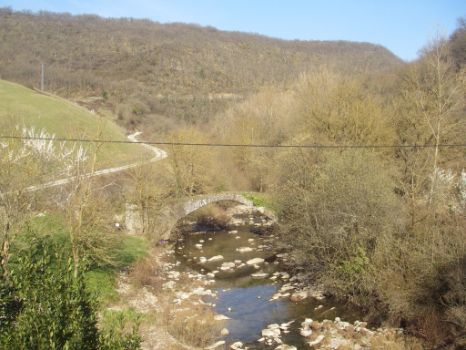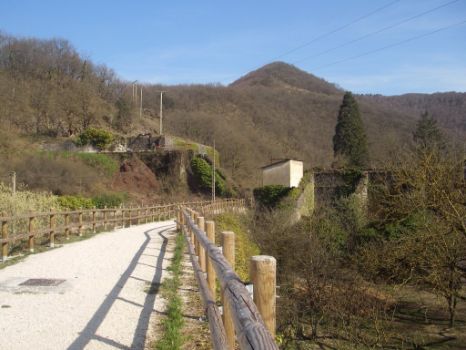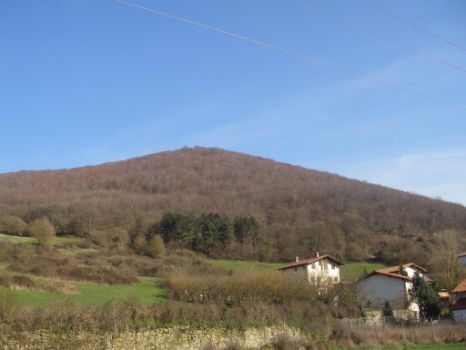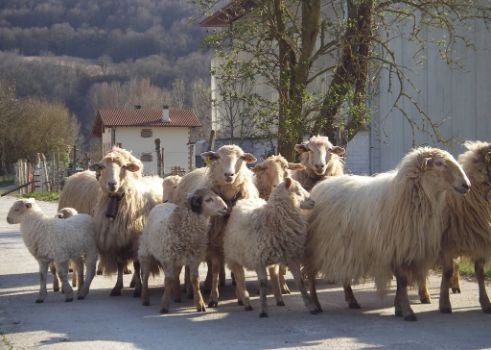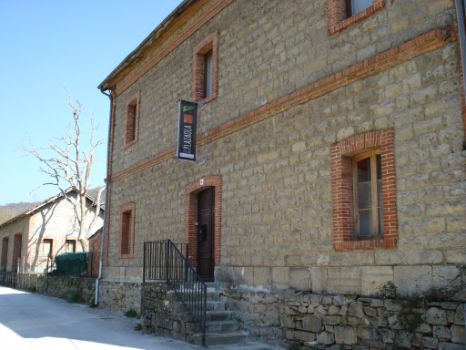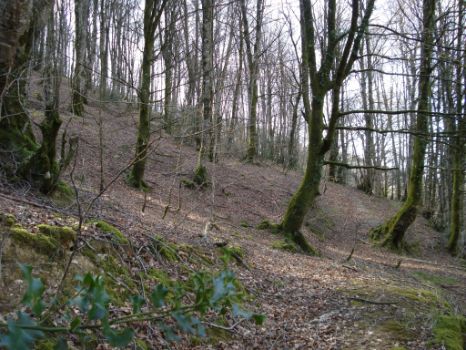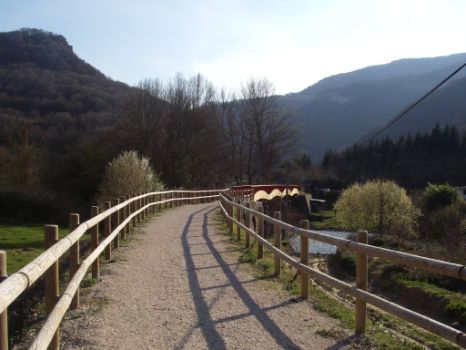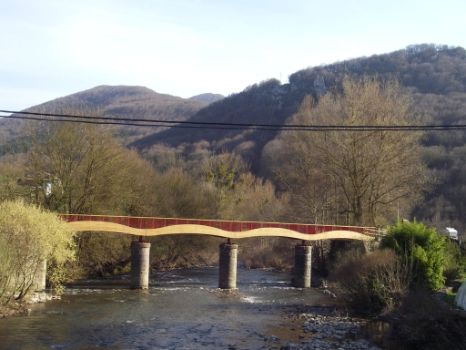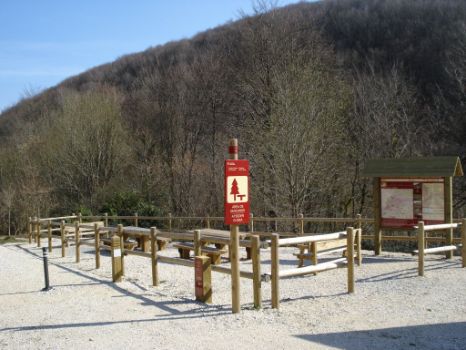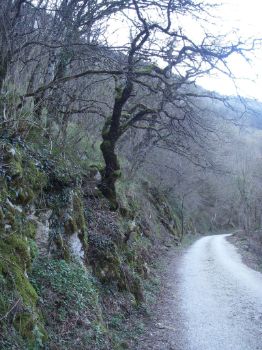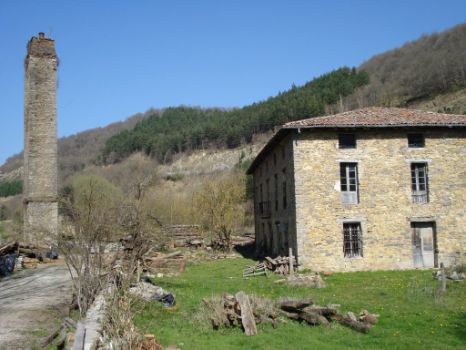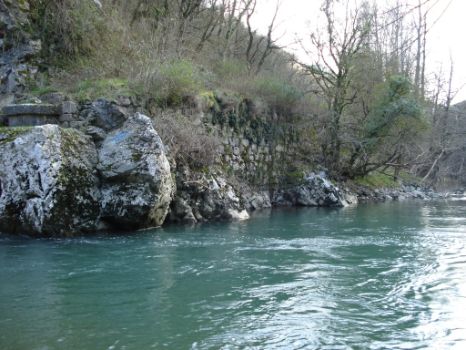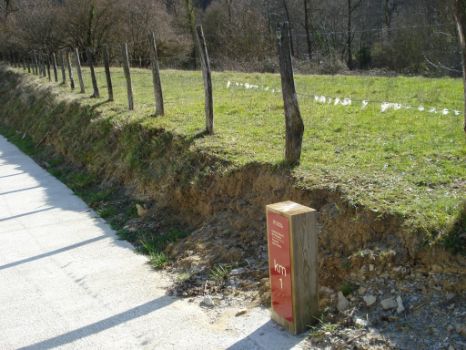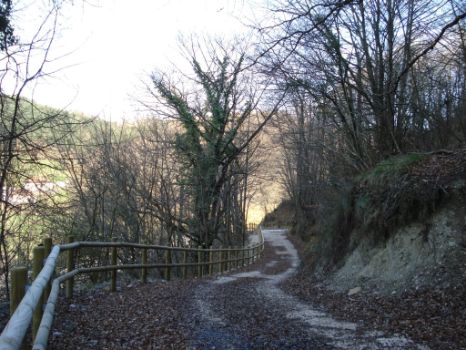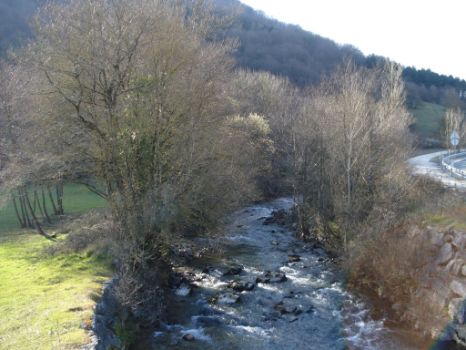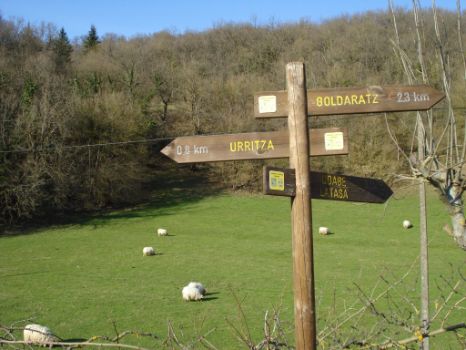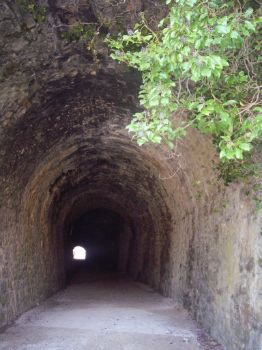Net of Natural
Trails

Plazaola Nature Trail. San Migeltxo rest area - Kaxarna rest area section
Description
A walk through humid Navarre, following the River Larraun
This Nature Trail covers part of the layout of the old railway of El Plazaola, a narrow-gauge steam railway that linked Pamplona to San Sebastián. Along the this route’s 6.3 km, travellers, guided on their way by the River Larraun, can enjoy a peaceful walk through the valleys of Imotz and Larraun, crossing lovely beech groves and oak woods interspersed with numerous meadows and hedges in the vicinities of towns such as Urritza and Latasa where they can also contemplate traditional architecture and enjoy the rich gastronomy of this north-eastern humid area of Navarre.
This Nature Trail’s starting point is located in the San Migeltxo rest area, around kilometre 8.4 of the NA-1300 highway, which links the luxuriant nature of the Lekunberry and Irurtzun valleys.
In this first section, the path runs parallel to the NA-1300 highway across a gravel surface that has been fully prepared for trekkers and cyclotourists and is maintained along most of the route. In a few metres, the crystal-clear waters of the River Larraun welcome travellers who, after passing an initial pedestrian walkway over the riverbed, are soon enveloped in a magical forest of beech trees (Fagus sylvatica) accompanied by hawthorns (Crataegus monogyna) and holly trees (Ilex aquifolium). This type of forest prevails in the highest areas of the route, producing different colours that enrich the valley landscape throughout the year.
To the left of the route, part of one of the numerous ironworks that were scattered across these valleys remains standing: old steel plants that transformed into metal the iron mineral that basically came from the mines of Gipuzkoa. The force of the river water and the calorific value of the coal provided by these forests were used for this purpose. Remains of the stone channels that were built to transport water to these industries can still be seen.
On continuing the route, a second metallic walkway appears that is used to cross over the River Larraun, which is surrounded by a lovely riverside forest containing numerous willows (Salix sp.), alder trees (Alnus glutinosa), blackberries (Rubus sp.) and hawthorns, and whose waters house a large trout community. With good reason, the River Larraun forms part of the Higher Salmonid Region of Navarre, which sustainably manages the wild trout populations that breed naturally in its waters.
A few metres further on, a small wooden walkway over the Cesal irrigation channel, which feeds the river that lends its name to the valley with its waters, leads to kilometre one of the trail, running next to the first meadows. Their evergreen pastures are used by autochthonous “latxa” sheep, whose greatly appreciated milk produces the venerated Idiazabal cheese.
The trail continues by descending the valley parallel to the River Larraun protected by a wooden balustrade on its right. After passing by a row of false cypresses (Chamaecyparis sp.), which stand out over the areas’ natural vegetation, you come to a concrete bridge where the path turns abruptly to the right to then climb the hillside and enter a mixed forest of beech trees, oaks (Quercus robur), hundred-year-old chestnuts (Castanea sativa) and an afforestation area of Radiata Pine (Pinus radiata). Among the few clearings that are offered by this dense mass of trees, you can see, perched on the valley’s opposite side, the small village of Urritza, one of these small places with deep-rooted traditions, located between forests and meadows, which constitute an unquestionable part of the charm of these valleys.
Following a downward section with a concreted surface and after progressing for a few metres parallel to the A-15 highway, travellers leave behind the village’s small cemetery and once again come to the River Larraun, whose unusual source located in the municipality of Iribas, at the foot of the Sierra of Aralar, has given it its nickname of GuadianaNavarro.
A few metres further on, the path continues next to some simple wooden benches, leaving to one side the service gate of the A-15, and makes headway along the left bank passing under the highway and arriving at the Venta de Urritza (Urritzako bentak). At this point, and once you have carefully crossed the NA-1300, the path turns to the left and continues for some 40 m along the road’s marked hard-shoulder as far as the first path on the right, which once again runs along the route of the old railway line of El Plazaola. At this point, there are signs pertaining to the Network of Trails of Imotz-Basaburua (Herrien Arteko Xendak), an old network of recovered rural paths that links together the different villages, which you can use to discover one of the lesser known yet most charming valleys of Humid Navarre.
Once it reaches kilometre 3 of the route and after crossing a 160-metre unlit tunnel, the trail continues along a section guarded by a wooden railing and which crosses one of the few original bridges of El Plazaola that are still standing and which serves to cross the Basaburua irrigation channel.
From this spot, looking leftwards, you will have a lovely view of the surrounding area, including the noteworthy beautiful, 18th-century, single-span, stone bridge and, a few metres further on, where the Basaburua irrigation channel and the River Larraun merge, the remains of the old El Pastaola railway line and a small hydroelectric power plant.
The path continues on its way towards Latasa parallel to the River Larraun on its right bank, offering a landscape characterised by pedunculate oak woods (Quercus robur) and Pyrenean oaks (Quercus pyrenaica) and small kitchen gardens and meadows, where you frequently come across flocks of “latxa” sheep grazing. As the path approaches Latasa, the oak forests give way to beeches and isolated Radiata pine stands. At approximately kilometre 4 of the route, you arrive at the lovely village of Latasa, where travellers can enjoy a well-deserved break in the refurbished rest area next to the new indoor fronton tennis court.
From this point, you can discern the perfectly preserved two-storey stone and brick building of the old station of Latasa (currently used as housing) and the ancillary building used to store goods. There is a Nature Trails plaque on its façade. Before continuing the route, it is worth taking a detour to visit this small hamlet where the old Royal Path that joined Pamplona and San Sebastián used to go. Worthy of note there is the Church of San Esteban, with its Gothic façade and outstanding tower, its well-made country houses, some bearing a 16th-century coat-of-arms on their facades, and the unusual fronton tennis court built in 1955, whose buttress (left-hand-side wall) contains the windows of the neighbouring house.
Once you have returned to the Nature Trail and after passing the station, you come to a crossroads with the NA-4130 highway, which you will have to cross once again with care, and continue straight ahead along a section that is protected by a wooden railing on both sides, until you cross the River Larraun via a new walkway built on the pillars of the old bridge of El Plazaola. In addition to contemplating the typical riverside forest that accompanies the river once again, on the left of the walkway you can enjoy beautiful views of Mount Arriketa and its oak and beech-tree covered hillsides; whereas, on the right, you can see the peaceful running of the water on leaving the hamlet of Latasa behind you.
After another pair of crossroads, where you must once again take care with the traffic, the itinerary heads to the village of Goldaratz, where you can join the GR-21 trail. The path, which is made of compact gravel once again, now continues parallel to the NA-1300 highway, offering excellent views of Mount Arriketa.
After crossing the highway once again, the track continues on its way delimited by a wooden railing on its left-hand-side, which separates it from the River Larraun, and by a crash barrier on the right, which protects it from the NA-1300 highway. The landscape accompanying trekkers in this part of the section is characterised by typical riverside vegetation and by oaks and beech trees that populate the sides of the nearby mountains. Once you have covered 700 m and after crossing the NA-1300 highway for the last time, level with the bridge over the River Larraun, the path continues along the bottom of the valley next to the river, boxed in between steep sides carpeted with thick, well-preserved woodland and which constitutes the perfect habitat for the abundant fauna you can find in the area, including species such as hares (Lepus sp.), foxes (Vulpes vulpes), badgers (Meles meles) and boars (Sus scrofa), whose presence can even be felt in the areas surrounding the villages.
After passing under the A-15 highway, between the impressive pillars supporting it, the limestone rock outcrops that can be seen on the opposite hillside become more prominent and their whiteness stands out among the trees. You can even discern specimens of birds of prey such as the common buzzard (Buteo buteo), the red kite (Milvus milvus) and the common kestrel (Falco tinnunculus), in addition to spotting the occasional colony of Eurasian griffons (Gyps fulvus), which live in the nearby rocks, and listening to the lively song of other small birds.
When you have reached kilometre 6, and after a bend on the right that follows the course of the river, another underpass below the highway allows you to see in the background the rest area of Kaxarna. This relaxation spot, located in the beautiful area where the railway bridge that crossed the river used to stand, invites you to rest and swim with views of a lovely oak wood on the rocky limestone hillside, which is covered with species such as butcher’s broom (Ruscus aculeatus), box (Buxus sempervirens), ivy and moss, once again evidencing the Atlantic properties that prevail in the valley.
At this point, in addition to the informative panel on the Nature Trail of El Plazaola which draws this route to a close, there is another showing the routes that can be taken from this point, such as the “Senda de los Pescadores” or the Fishermen’s Trail (SL-NA 140) and the Aitxita Trail (SL-NA 131), and which links this Nature Trail to Irurtzun, passing by an old ironworks and by the impressive limestone pass of Dos Hermanas.
Managing Entities
Sites of interest
Puntos de interés
Infrastructure
Municipality
Hostel
Vegetation
Profile

(Calculated according to the MIDE criteria for an average excursionist with a light load)
Highlights
Further information
Valley of Larraun
The Valley of Larraun is a small valley in the northwest of Navarre, boxed in between the Sierra of Aralar and a series of small mountains such as the massif of Araxes and the mountains of Azpirotz and Leitza, which are all of a marked limestone nature.
In this geographical region, there lies the eponymous municipality formed of Albiasu, Aldatz, Alli, Arruitz, Astita, Azpirotz-Lezaeta, Baribar, Etxarri, Errazkin, Gorriti, Uitzi, Iribas, Madotz, Mugiro and Oderitz.
The valley has an average altitude of some 1000 m and occupies the transition area between the Atlantic and Mediterranean zones. It features green, luxuriant vegetation, with a mosaic of meadows and extensive oak and chestnut forests that cover the bottom of the valley and has thick, well-preserved beech groves occupying the top part of the hillsides.
The geological substrate of the valley of Larraun, which is formed of a series of Mesozoic materials from the Triassic and Late Cretaceous periods, stands out not only because it encompasses significant karstic phenomena and has some of the most well-known caves in Navarre, such as Mendukilo, Akelar, Artzainzulo and Lezegalde, but also because it is home to numerous aquifers and emergences. Other interesting sites that can be visited in this municipality are Larraspil and the source of the River Larraun and the route of the Dolmens together with the Nature Trail of El Plazaola.
“Latxa” sheep
“Latxa” sheep are a popular ovine breed from the Basque Country, Navarre and the rest of the Cantabrian Coast and are possibly the most primitive of Spanish sheep breeds. The word “latxa”, of Basque origin, means "enough" and refers to the type of long, crude wool of this breed’s sheep.
The history of the “latxa” breed has been linked to the mountain areas of Navarre where, in the past, it was the way large numbers of families, who found a significant addition to the family economy in farming these sheep, made a living.
This breed of sheep offers a series of properties that characterise it, such as its uncouth character, its agile movements and its high rural nature. Worthy of note is its perfect adaptation to rough terrain with high rainfall, thanks to the fact that its wool does not retain water, thus allowing the sheep to dry quickly. The aggressiveness of its rams also stands out.
OTargeted at the production of milk as its main goal, they are used to make cheeses that are renowned for their excellent quality, such as the designation of origin cheeses of Idiazabal and Roncal. The lambs are weaned very early on in order to reserve milk for cheese manufacture and they are slaughtered as suckler lambs or "lechazos" at an age of approximately 30 days and with a live weight of between 10 and 12 kg. These lambs’ meat is in great demand and highly valued.
In the past, this breed’s characteristic coarse wool was used to make mattresses, which is the origin of the applied designation of “mattress wool”. It is currently exported and used to manufacture carpets, tapestries, etc.
Country houses; houses with a name of their own
The small villages that are crossed by this Nature Trail are home to excellent examples of one of the most representative elements of the traditional architecture of Navarre and the Basque Country. They are the country houses; large buildings that are mostly built of stone, with lengthwise gable roofs and usually two or three stories high.
Traditionally built on their own or in small groups, the ground floor was used to house cattle, fodder and other agricultural products collected from the lands that usually surrounded the building, whereas the rooms of the family home were located on the upper stories.
In the past, ownership of these country houses used to fall on the eldest son, although it was the women in the family who were tasked with administering the property and the harvests. One peculiarity of these typical buildings is that they have their own name, which usually refers to the name of the place where they are located, such as "Garaicoetxea" (the house at the top) or "Azpikoetxea" (the house at the bottom), or the family it belongs to.
The Plazaola train
At the outset, this narrow-gauge, steam-traction railway was a mining train, which, at the beginning of the 20th century, used to transport iron from the mines of Plazaola to Andoain (Gipuzkoa). In 1914, the Plazaola was transformed into a passenger train, which linked, over 84 kilometres, Pamplona to San Sebastián. In this way, during the forty years it was in operation, it became a commercial and communication route between Navarre and Gipuzkoa, as well as an axis of cultural interchange.
Although it did not stand out on account of its economic importance, it was very popular along its entire route, where it was commonly known as "the Plazaola", "the Plazaola train", "the Plazaola railway" and also as the "txiki" train (although this nickname was also used locally for other trains, such as, for example the train from Irún to Elizondo).
The stations that provided regular services of this railway were: Pamplona (city), Pamplona (junction), Aizoain, Sarasa, Gulina (halt), Irurtzun, Latasa, Lecunberri, Uitzi, Leitza, Areso (halt), Plazaola, Ameraun (halt), Olloki, Andoain, Lasarte (Bilbao-Ferrocarriles Vascongados junction), Añorga and Donostia (Amara). There were two other halts, Bizkotx and Beiñes, although the train did not stop there on a regular basis.
DDue to the floods of October 1953, which took several bridges and sections of the track with them and left the railway line unusable, and to stiff competition from the bus routes, in this same year, the decision was taken to close the line for passenger transportation, although it continued providing other goods services in the Leitzaran of Gipuzkoa. It was finally closed in 1958, when the track was removed and the facilities were dismantled.
A significant part of the old railway route has recently been refurbished as a route for leisure activities, constituting the so-called El Plazaola Nature Trail, which runs between meadows and forests, both autochthonous (oaks, beech trees, riverside alders, etc.) as well as pine grove afforestation, and crosses the valleys of Larraun and of the River Leitzaran (declared a Protected Biotope).



